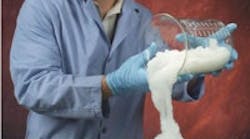Scientists at Argonne National Laboratory, Argonne, Ill., are working to develop a technique for cleaning certain types of radioactive materials from concrete using a super-absorbent gel and engineered nanoparticles. In the event of a terrorist attack using a dirty bomb or other radioactive dispersion device, the gel would be used to clean a site so people could safely enter it.Super Gel
Argonne researchers are designing a system to safely capture and dispose of radioactive elements on porous structures, such as buildings and monuments, using this spray-on, super-absorbent gel and engineered nanoparticles.
This is how it works: Following detonation, radioactive isotopes settle on surfaces in the area. Moisture in porous materials dissolves the radioactive particles and pulls them into these surfaces. To remove the radioactive substances, a wetting agent and a super-absorbent gel are applied onto the contaminated surface from a remote location. The wetting agent causes the radioactive material to resuspend in the water in the pores. The super-absorbent polymer gel then draws the radioactive-laden water out of the pores, while the engineered nanoparticles irreversibly capture the radioactive molecules. The dried gel is then vacuumed and recycled, leaving only a small amount of radioactive waste.“The polymer gel we use to absorb the radioactivity is similar to the absorbent material that’s found in disposable diapers,” says Michael Kaminski, leader of Argonne’s nanoscale engineering group. “When exposed to a wetting agent, the polymers start to cross-link, forming something like a structural scaffold that allows the gel to absorb an incredible amount of liquid.” Kaminski’s group has shown that a single application of the gel can remove up to 90% of the radioactive element under observation. “This level of success has never been achieved before,” Kaminski says. “Right now, it is common practice to demolish the contaminated materials in hopes of getting rid of the radioactivity. Our technique would allow surfaces to be preserved, which means that we wouldn’t have to deface monuments or buildings just to remove the radiation.”The group has 18 months to complete development of the decontamination method. The project will culminate in a prototype demonstration using contaminated concrete samples. This work is being done as part of an interagency Technical Support Working Group project that is funded by the Department of Homeland Security. Other groups are working on complementary technology; for example, a method by which to map or scan radioactive levels in a contaminated area.
This is how it works: Following detonation, radioactive isotopes settle on surfaces in the area. Moisture in porous materials dissolves the radioactive particles and pulls them into these surfaces. To remove the radioactive substances, a wetting agent and a super-absorbent gel are applied onto the contaminated surface from a remote location. The wetting agent causes the radioactive material to resuspend in the water in the pores. The super-absorbent polymer gel then draws the radioactive-laden water out of the pores, while the engineered nanoparticles irreversibly capture the radioactive molecules. The dried gel is then vacuumed and recycled, leaving only a small amount of radioactive waste.“The polymer gel we use to absorb the radioactivity is similar to the absorbent material that’s found in disposable diapers,” says Michael Kaminski, leader of Argonne’s nanoscale engineering group. “When exposed to a wetting agent, the polymers start to cross-link, forming something like a structural scaffold that allows the gel to absorb an incredible amount of liquid.” Kaminski’s group has shown that a single application of the gel can remove up to 90% of the radioactive element under observation. “This level of success has never been achieved before,” Kaminski says. “Right now, it is common practice to demolish the contaminated materials in hopes of getting rid of the radioactivity. Our technique would allow surfaces to be preserved, which means that we wouldn’t have to deface monuments or buildings just to remove the radiation.”The group has 18 months to complete development of the decontamination method. The project will culminate in a prototype demonstration using contaminated concrete samples. This work is being done as part of an interagency Technical Support Working Group project that is funded by the Department of Homeland Security. Other groups are working on complementary technology; for example, a method by which to map or scan radioactive levels in a contaminated area.
